Yoshimura history – 17
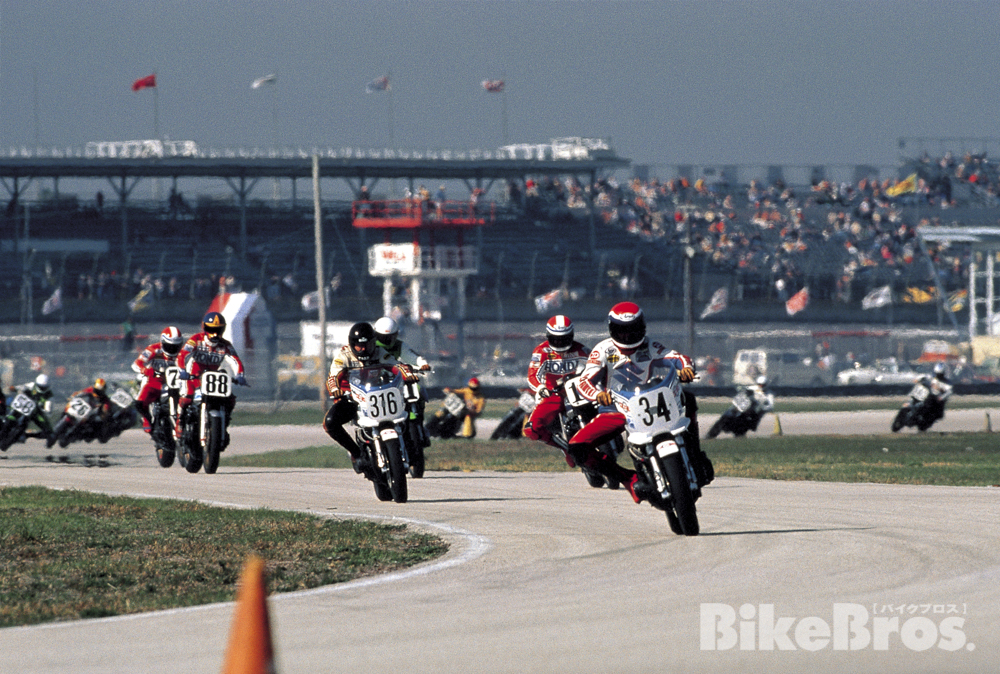
The lead pack about to enter the second horseshoe on the flat infield at Daytona International Speedway during the 1981 season opener. Here, #34 W. Cooley (GS1000S) is being chased by #19 F. Spencer (CB900F), #316 G. Crosby (GS1000S), with #21 E. Lawson (KZ1000J), #88 R. Pietri (CB900F), #73 M. Spencer (CB900F), #56 D. Emde (KZ1000J), #26 J. Adamo (Ducati 900SS).
Yoshimura History #17: The Technological Innovation Behind Cooley’s First Daytona Victory
1980-1981 Some Big Changes
“We’re gonna sue you! Be prepared!” Fujio was yelling at the U.S. Kawasaki mechanics, following the end of the 1980 AMA Superbike season’s final round at Daytona International Speedway on October 5. It was absolutely unacceptable that the conclusion of a total of 10 races is such an absurd ruling.
First, right before the start of the race, Eddie Lawson’s #21 KZ1000 MK-II developed engine trouble and began to run on three cylinders. The U.S. Kawasaki factory team pulled both of their two bikes —- not only Lawson’s #21 but also his teammate David Aldana’s #109 —- into the garage. After a while, #21 emerged from the garage, but for some reason, not #109. The bike #21 now had different set of forks, brakes and handlebars. The “Go Eddie” sign that had always been on its tail cowl was gone. Obviously, they had switched the number plates on their bikes, which was definitely a violation of regulations.
When Wes Cooley noticed this on the grid, he protested to the AMA officials. Identification should have been easy, since every superbike is based on a production bike and has a VIN number stamped on its frame. However, the AMA at the time did not keep records of VINs during the inspection, so it was impossible to distinguish the real #21 from the fake one. Cooley’s protest was rejected.
The final race thus started off, with Cooley (Yoshimura Suzuki GS1000S), Lawson (U.S. Kawasaki KZ1000 MK-II), Freddie Spencer (American Honda CB750F), Mike Baldwin (American Honda CB750F) and Mike Spencer (Yoshimura Suzuki GS1000S) going full send from the very start.
On Lap 6, Eddie Lawson crashed when his rear tire slipped on oil from his engine. This took him out of contention for the win and the championship. The race then became a fierce battle between Cooley and Freddie Spencer, which was won by Cooley. The championship was in Cooley’s grasp with a 6-point margin.
But then U.S. Kawasaki claimed that Cooley’s GS1000S was violating the chassis modification rules, and the AMA accepted the claim. This left Freddie Spencer in 1st place, Mike Spencer in 2nd and Baldwin in 3rd; and the championship went to Lawson (121 points) in 1st, Freddie Spencer (115 points) in 2nd and Cooley (115 points) in 3rd. This angered Fujio, who protested strongly, but AMA did not accept his objection, and Cooley was marked as Provisionally Disqualified.
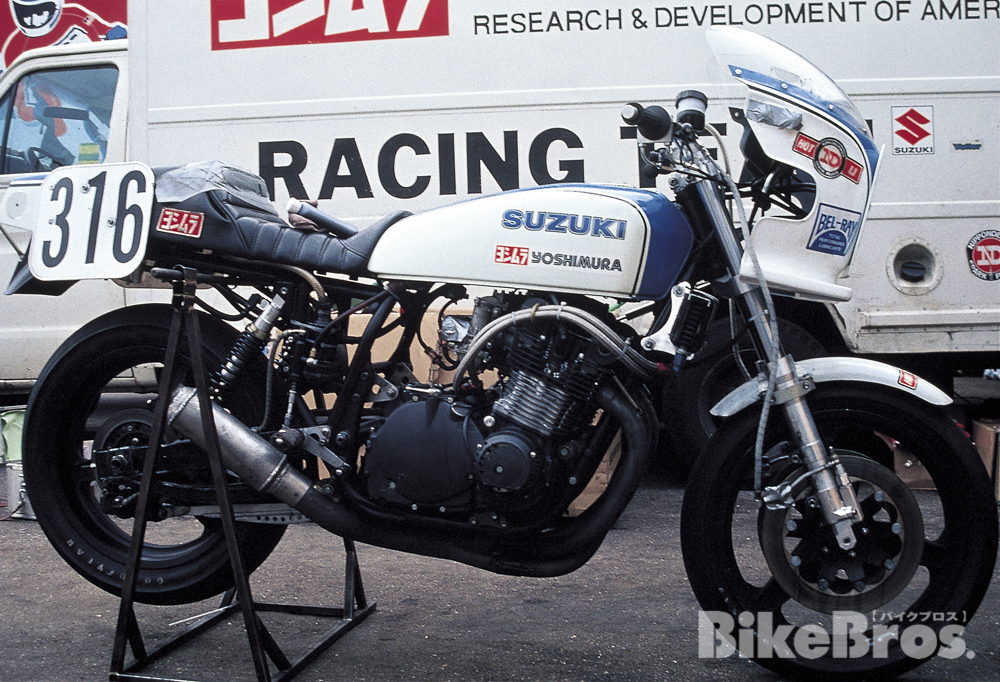
Yoshimura Suzuki GS1000S. Following the AMA regulations which limit engine displacement to 1025cc, its engine was increased to 1023cc by boring out from φ70mm to φ70.9mm (stroke remained at 64.8mm). It ran computer-designed camshafts and a set of 31mm Keihin CR carbs, and was fitted with a basic 4-1 exhaust system. The forks were φ40mm KYB ANDF (Anti Nose Dive Fork) with billet aluminum legs, custom made for factory teams. The laid-down rear shocks were remote-reservoir KYBs, also exclusive to works race bikes. The swingarm featured square tube aluminum construction with underbracing. The wheels were 18-inch cast magnesium Dymags front and back. The headlight fairing was mounted on the frame. Shown here is Crosby’s bike for 1981 season.
Cooley’s GS1000S had fallen during a test at his hometown of Willow Springs, California, just before the final round at Daytona, and had this repair (including gusset welds) done to the seat rail. Although it was only for the repair and nothing more, U.S. Kawasaki called it a “chassis modification violation”. It would have been a violation if the purpose of the act was to reinforce the frame, but the repair was done on the seat rail, which has nothing to do with the main frame. And first of all, if they wanted to make it an issue, they should have placed the claim during the pre-race inspection —- not after Lawson’s crash and retirement from the race.
After a long wait, in December, the AMA finally ruled that Wes Cooley had won the race, putting him in 1st place in the championship standings with 128 points, Eddie Lawson 2nd with 121 points, and Freddie Spencer 3rd with 111 points. The victory made Cooley crowned AMA Superbike Champion for the second year in a row.
The AMA’s ruling went like this: Eddie Lawson was disqualified for an unauthorized vehicle change before the race, and the disqualified rider had no right to protest. In other words, the claim by U.S. Kawasaki (Lawson) against Yoshimura (Cooley) regarding the chassis modification violation was itself invalid. The key evidence was a set of photographs taken by Cycle News (America’s weekly motorcycle newspaper), which showed that the bike #21 was clearly different between the pre-final and the final.
Fujio’s “most frustrating feeling ever” was thus officially resolved.
Two other momentous events occurred in 1980. These were major engineering turning points for Yoshimura. The first was Pop’s invention of the Cyclone muffler for inline 4-cylinder engines. As opposed to conventional 4 into 1 exhaust pipe —- designed with #1 and #4 pipes at the top and #2 and #3 pipes at the bottom —- Yoshimura Cyclone allows exhaust pulses to reach the collector (merge) section in the same sequence as the firing order —- 1-2-4-3 —- creating a counterclockwise flow. The flow then creates a whirlpool (a swirl effect) that sucks in the exhaust gas and increases exhaust-flow velocity, which in turn gives the engine a significant increase in torque in the low-to-mid rev range, as well as an extra kick at the top end. The Cyclone muffler was initially developed for Yoshimura’s own racing use, then subsequently for street use, however, it was intended to be developed, produced and marketed only in Japan, where Pop resided.
In October 1980, Yoshimura factory was moved to a new location in Aikawa-machi in Aiko-gun, Kanagawa Prefecture, where Yoshimura Japan is now located. Concurrently, the company changed its name from “Yoshimura Parts Shop Kato” to “Yoshimura Parts of Japan” and invested on a high-performance engine dynamometer for the new site (approx. 2000m2) which is much larger than the previous locations.
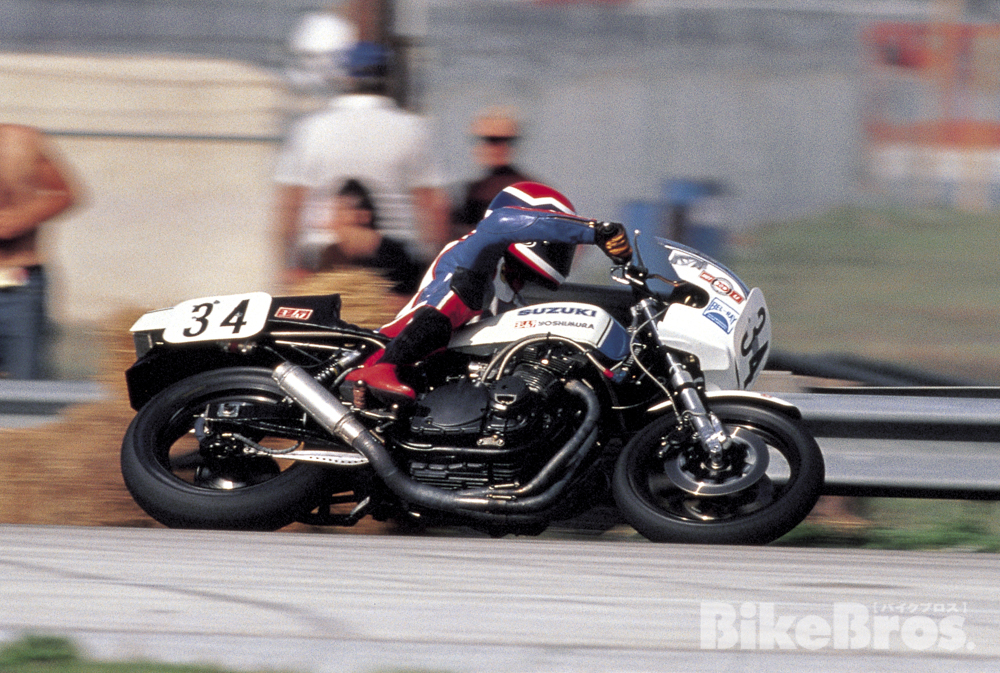
Turn 1 at Daytona International Speedway Road Course. From the 18-degree banking in front of the grandstands to the completely flat infield, Yoshimura’s first contract rider Wes Cooley dips his GS1000S deep into the left turn. For an American rider, a “Daytona win” during the March Bike Week is not just a victory, but a very special honor that will be etched in the history books.
Second, Fujio invested on a computer. Suggested by a local machine shop, Fujio visited a computer store in LA and asked for a custom computer program to design mechanical parts, but it didn’t work out as computer programming was still a new field at the time and the hardware itself was quite expensive. He had almost left the store, but then he thought, “Wait a minute. This is a chance to challenge myself.” He returned to the store counter and bought a computer. It was a Hewlett-Packard HP-41C, a hand-held programmable calculator equipped with 1980’s cutting-edge computing performance along with expansion capabilities —- featuring peripheral ports for a portable printer, memory module, or storage device —- that allows users to write programs onto magnetic tape.
The HP-41C was a real workhorse. It was said that the same “machine” was also used by Japanese Self Defense Force pilots (perhaps in the same way as Pop used a slide rule for air navigation during WW2!). However, the HP-41C was bare-bones and everything had to be done from scratch. Through struggling with English computer terminology and BASIC programming language, Fujio by himself wrote the code for the calculation of valve lift curve —- describing cam profile degree by degree —- to design original camshafts. Fujio’s computer program written on the HP-41C enabled him to design a wide variety of camshafts in a single hour, and to produce precision “template cams” with high accuracy. From these “template cams” he made “master cams” which then were placed on a camshaft grinder (cam copier) to mass-produce them.
While Pop practiced daring tuning methods based on his experience, intuition and ideas, Fujio strongly believed that theoretical approach and computer implementation would be his engineering assets. And with the brilliant BASIC program he wrote, he made his first computer-designed camshaft for 1981 Daytona. It marked the beginning of a new era in cam design, which is the key element of cylinder head tuning.
And there was a man who always experience hard luck in Daytona. The man was Yoshimura’s ace rider, Wes Cooley, who finished with 4th place in his Daytona debut in 1976, then 3rd place in 1977, retired due to a broken oil cooler in 1978, then 2nd place suffering a brake failure in 1979, and then retired due to a broken crankshaft in 1980. During the years, Yoshimura won three consecutive Daytona Superbike championships (with Steve McLaughlin in 1978, Ron Pierce in 1979, and Graeme Crosby in 1980). Therefore, Crosby, who was also making a spot entry in 1981 Daytona, really wanted Cooley to win. “If Yoshimura was going to win, this time it was going to be with Cooley.” That is the kind of man Crosby is.
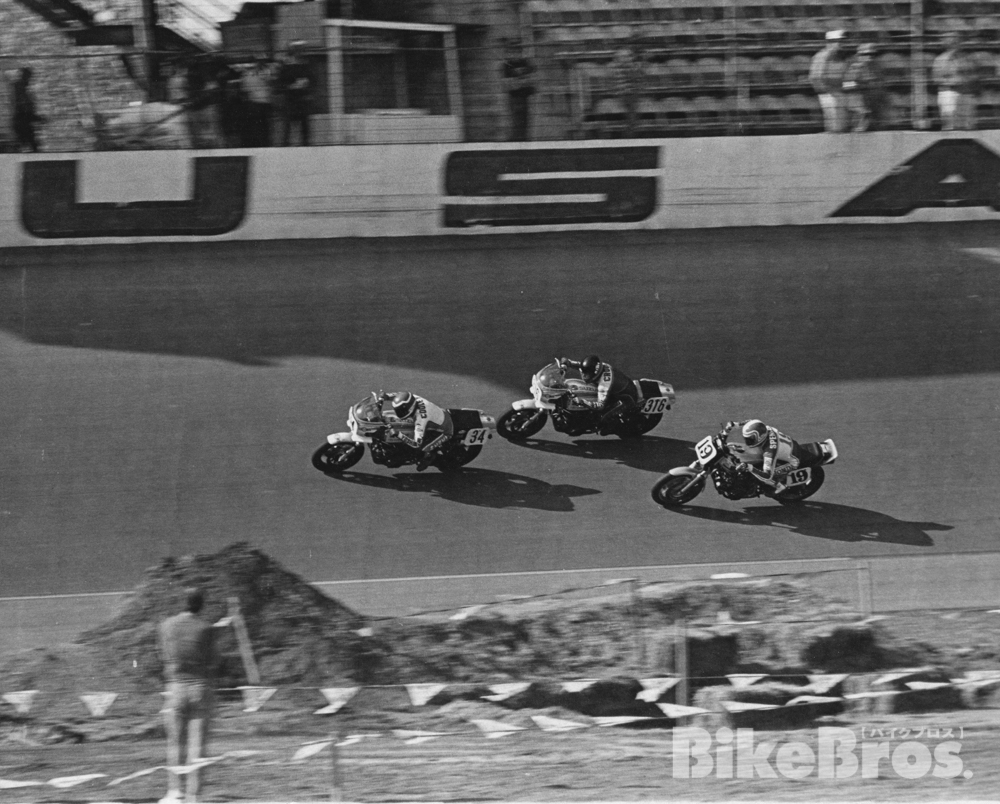
Daytona International Speedway is a tri-oval (triangle oval) with enormous 31-degree banks in the east and west turns, and 18-degree bank in front of the grandstands. As shown in the photo above, #34 W. Cooley (GS1000S), #316 G. Crosby (GS1000S) and #19 F. Spencer (CB900F) were so close until the midrace stage. Who wants to take the lead into the last lap?
The 1981 Daytona Superbike was a close race between Cooley, Crosby (both aboard Yoshimura Suzuki GS1000S) and Freddie Spencer (aboard American Honda CB900F). The season-opening round was not a 50-mile but a 100-mile, 26-lap race that included one fuel stop. In Lap 12, F. Spencer had a fire accident during refuel, and although he managed to return to the track, there was a huge gap between him and the Yoshimura riders. Both Cooley and Crosby pitted at the same time and completed the refueling without any trouble. It was now a match race between the two.
In the last lap, Cooley found himself in a bad position. He was in the lead with Crosby following him. Crosby was expected to use drafting (or as Europeans call it, slipstreaming) as Cooley veers down the Turn 4 (31-degree east bank) and climbs up the 18-degree bank to the finish line. Cooley tried to pull ahead further, then Crosby made a mistake at the exit of the chicane —- slid his rear —- just before entering the Turn 4. Crosby tried hard to recover but finished 2nd, just 0.7 seconds behind the winner, followed by F. Spencer in 3rd. The result was exactly how Crosby wanted it: Cooley’s first Daytona victory and Yoshimura’s fourth consecutive Daytona Superbike win.
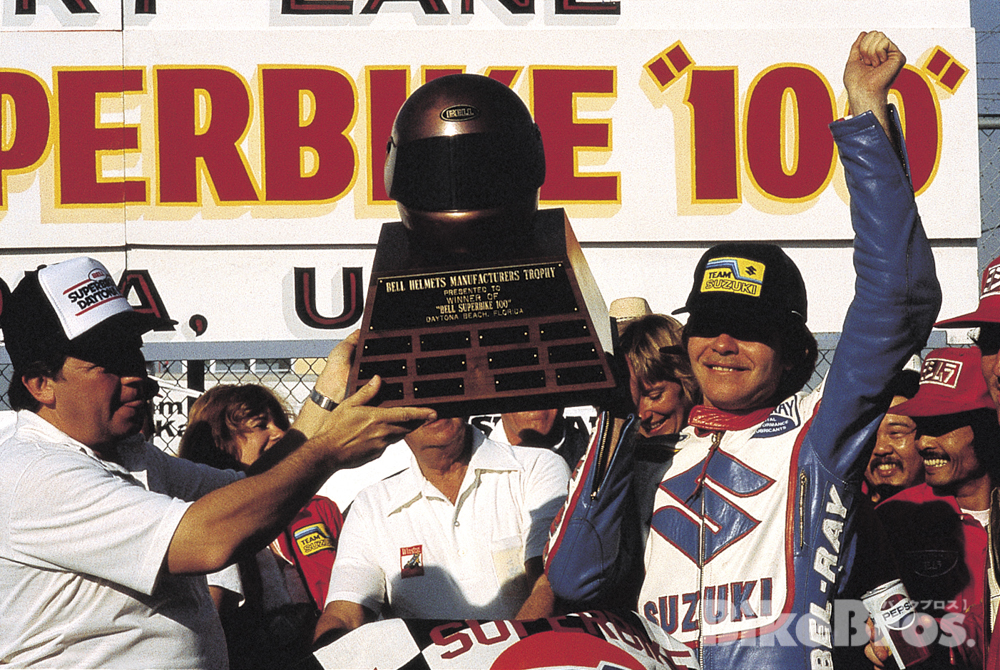
Wes Cooley was definitely the winner of the 1981 Bell Superbike 100 at Daytona (sponsored by Bell Helmet). Strictly speaking, Cooley’s first Daytona victory was 1980 season-closing 50-mile race. The 1981 season-opening 100-mile victory was his second, but hey, when people say “Daytona,” it’s the season-opener in March.
In the U.S., Yoshimura R&D of America made Wes Cooley win his first Daytona victory, with the Yoshimura Suzuki GS1000S equipped with Fujio’s first computer-designed cam. In Japan, Yoshimura Parts of Japan (former Yoshimura Parts Shop Kato) was developing Pop’s invention, the Cyclone muffler. Thus, in both obvious and less obvious ways, the engineering revolution was underway.
============================================================
Published on November 29, 2021
Stories and photos supplied by Yoshimura Japan / Cycle World / Tomoya Ishibashi
Written by Tomoya Ishibashi
Edited by Bike Bros Magazines
[ Japanese Page ]
